xMEMS Announces World's First Monolithic MEMS Speaker
by Andrei Frumusanu on July 7, 2020 9:00 AM EST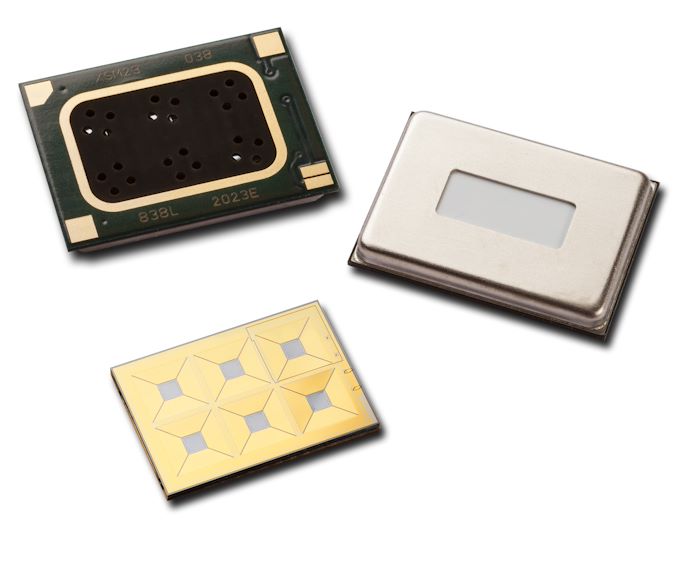
Speakers aren’t traditionally part of our coverage, but today’s announcement of xMEMS’ new speaker technology is something that everybody should take note of. Voice coil speakers as we know them and have been around in one form or another for over a hundred years and have been the basis of how we experience audio playback.
In the last few years, semiconductor manufacturing has become more prevalent and accessible, with MEMS (Microelectromechanical systems) technology now having advanced to a point that we can design speakers with characteristics that are fundamentally different from traditional dynamic drivers or balanced armature units. xMEMS’ “Montara” design promises to be precisely such an alternative.
xMEMS is a new start-up, founded in 2017 with headquarters in Santa Clara, CA and with a branch office in Taiwan. To date the company had been in stealth mode, not having publicly released any product till today. The company’s motivations are said to be breaking decades old speaker technology barriers and reinventing sound with new innovative pure silicon solutions, using extensive experience that its founders have collected over years at different MEMS design houses.
The manufacturing of xMEMS’ pure silicon speaker is very different to that of a conventional speaker. As the speaker is essentially just one monolithic piece manufactured via your typical lithography manufacturing process, much like how other silicon chips are designed. Due to this monolithic design aspect, the manufacturing line has significantly less complexity versus voice coil designs which have a plethora of components that need to be precision assembled – a task that is quoted to require thousands of factory workers.
The company didn’t want to disclose the actual process node of the design, but expect something quite crude in the micron range – they only confirmed that it was a 200mm wafer technology.
Besides the simplification of the manufacturing line, another big advantage of the lithographic aspect of a MEMS speaker is the fact that its manufacturing precision and repeatability are significantly superior to that of a more variable voice coil design. The mechanical aspects of the design also has key advantages, for example higher consistency membrane movement which allows higher responsiveness and lower THD for active noise cancellation.
xMEMS’ Montara design comes in an 8.4 x 6.06 mm silicon die (50.9mm²) with 6 so-called speaker “cells” – the individual speaker MEMS elements that are repeated across the chip. The speaker’s frequency response covers the full range from 10Hz to up to 20KHz, something which current dynamic driver or balanced armature drivers have issues with, and why we see multiple such speakers being employed for covering different parts of the frequency range.
The design is said to have extremely good distortion characteristics, able to compete with planar magnetic designs and promises to have only 0.5% THD at 200Hz – 20KHz.
As these speakers are capacitive piezo-driven versus current driven, they are able to cut power consumption to fractions of that of a typical voice coil driver, only using up 42µW of power.
Size is also a key advantage of the new technology. Currently xMEMS is producing a standard package solution with the sound coming perpendicularly out of the package which has the aforementioned 8.4 x 6.05 x 0.985mm footprint, but we’ll also see a side-firing solution which has the same dimensions, however allows manufacturers to better manage internal earphone design and component positioning.
In the above crude 3D printed unit with no optimisations whatsoever in terms of sound design, xMEMS easily managed to design an earphone of similar dimensions to that of current standard designs. In fact, commercial products are likely to looks much better and to better take advantage of the size and volume savings that such a design would allow.
One key aspect of the capacitive piezo-drive is that it requires a different amplifier design to that of classical speaker. Montara can be driven up to 30V peak-to-peak signals which is well above the range of your existing amplifier designs. As such, customers wishing to deploy a MEMS speaker design such as the Montara requires an additional companion chip, such as Texas Instruments’ LM48580.
In my view this is one of the big hurdles for more widespread adoption of the technology as it will limit its usage to more integrated solutions which do actually offer the proper amplifier design to drive the speakers – a lot of existing audio solutions out there will need an extra adapter/amp if any vendor actually decides to actually make a non-integrated “dumb” earphone design (As in, your classical 3.5mm ear/headphones).
TWS (True wireless stereo) headphones here obviously are the prime target market for the Montara as the amplifier aspect can be addressed at design, and such products can fully take advantage of the size, weight and power advantages of the new speaker technology.
In measurements, using the crude 3D-printed earphone prototype depicted earlier, xMEMS showcases that the Montara MEMS speaker has significantly higher SPL than any other earphone solution, with production models fully achieving the targeted 115dB SPL (The prototype only had 5 of the 6 cells active). The native frequency response here is much higher in the higher frequencies – allowing vendors headroom in order adapt and filter the sound signature in their designs. Filtering down is much easier than boosting at these frequencies.
THD at 94dB SPL is also significantly better than even an unnamed pair of $900 professional IEMs – and again, there’s emphasis that this is just a crude design with no audio optimisations whatsoever.
In terms of cost, xMEMS didn’t disclose any precise figure, but shared with us that it’ll be in the range of current balanced armature designs. xMEMS’ Montara speaker is now sampling to vendors, with expected mass production kicking in around spring next year – with commercial devices from vendors also likely to see the light of day around this time.


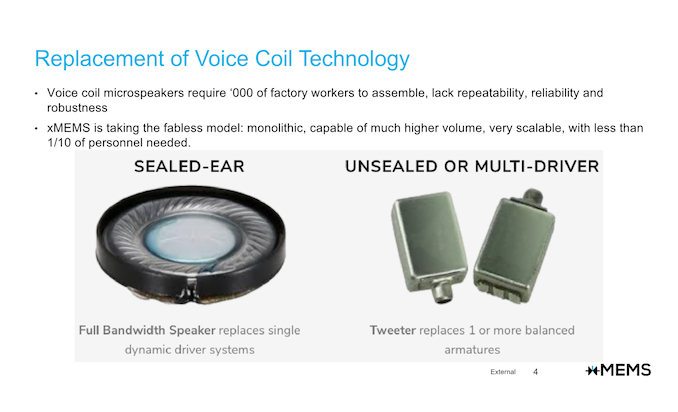
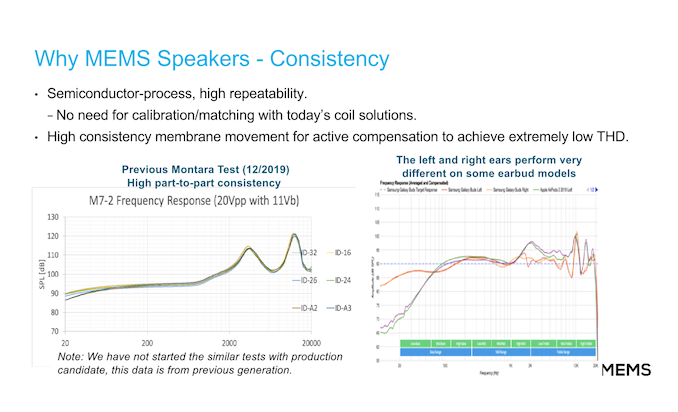
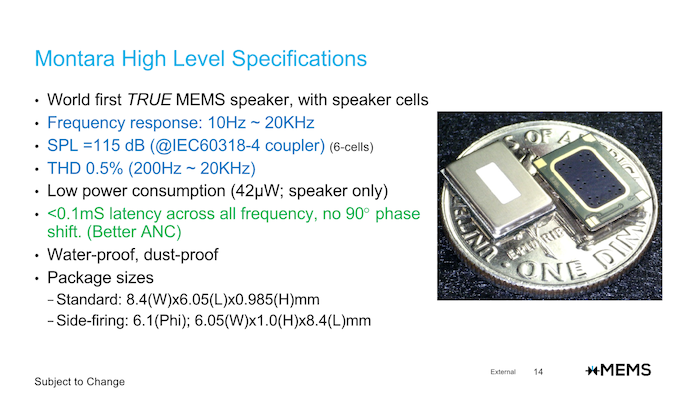
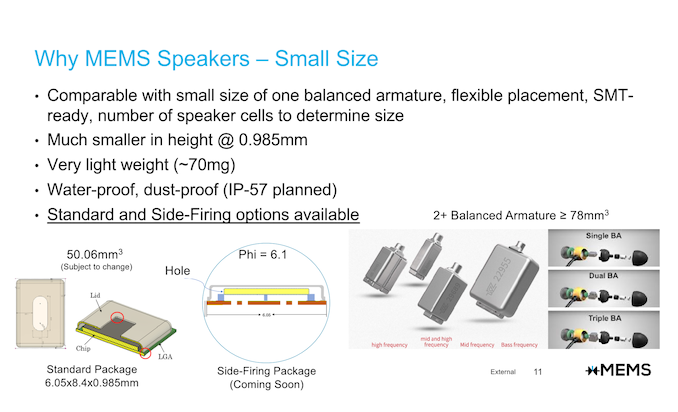

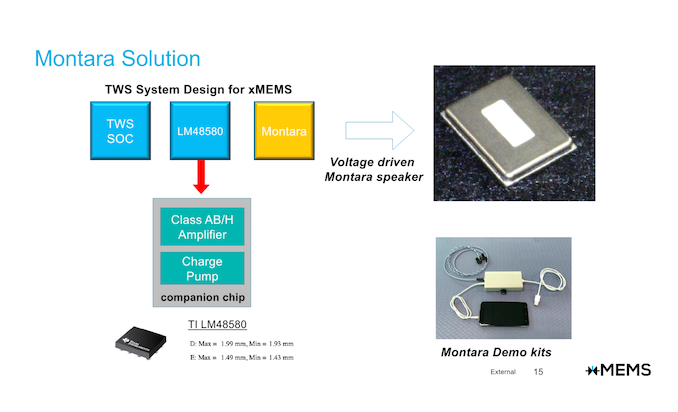
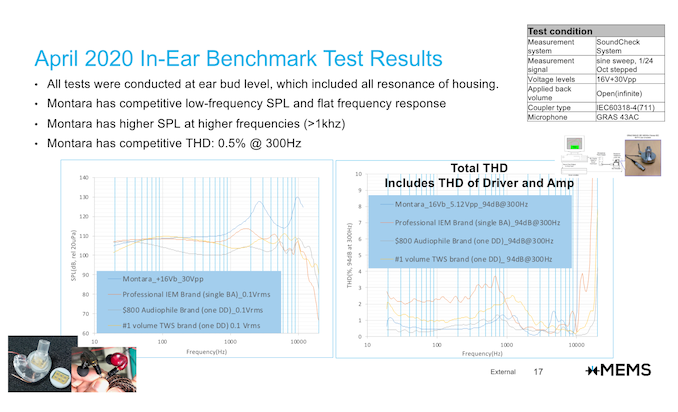
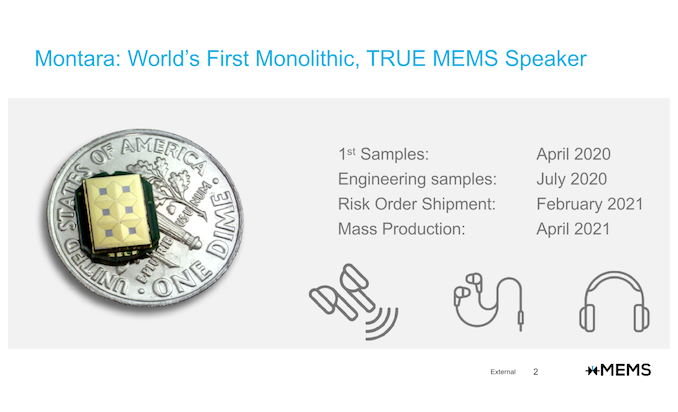








58 Comments
View All Comments
mode_13h - Tuesday, July 7, 2020 - link
Thanks for the link. I've long bought pro audio gear as it's mostly neutral-sounding, well-built, and good value for money. But I'm always a fan of quantitative measurements.MrVibrato - Wednesday, July 8, 2020 - link
Attempting to redefine the label "audiophile" with all the idiot-baggage attached to it is rather quite futile, if you ask me. But hey, if you like to assign that label to yourself and then fight it, well, whatever floats your boat...2M2B - Wednesday, July 8, 2020 - link
The audiophile community already had meltdowns when Amir showed a $1000 DAC couldn't handle 16 bit audio let alone 24 bit stuff. The community is a joke i don't why people bother with it.mode_13h - Tuesday, July 7, 2020 - link
That you rarely miss a chance to bash gamers, weeaboos, audiophiles, or the like, probably says more about you than you're actually saying about them. It's so bad that find it surprising when I see a post by you that isn't bashing one of these groups.I'm not trying to be defensive, either. I don't consider myself a member of those groups, but sometimes you gotta just look at what you're putting out into the world and ask yourself if it really needs to be said.
brucethemoose - Tuesday, July 7, 2020 - link
You can get away with less air movement with a sealed IEM, as they allude to in the press release.Otherwise, yeah... you'd want a dynamic (or better yet, a planear magnetic) driver hooked up in some kind of low pass config in headphones or speakers. And then you'd either need an amped source, a seperate amp or a coil that's happy with 30V input.
2M2B - Wednesday, July 8, 2020 - link
They ignore that it the same for balanced armatures, The power needed a joke when BAs need nowhere near that for 122db output. This is a portable headphone not a home desktop set up. lolwillis936 - Thursday, July 9, 2020 - link
Indeed. Open bench measurements are not at all indicative of what you get out of a sealed cavity. IEMs are the gold standard for accurate audio. No chance for multipath. If you want to see how dramatic the issue is, take your fanciest pair of headphones, put it next to your nicest mic, play white noise, and observe the magnitude response. Continue to observe the response in real time as you move the headphone around. Several dB across the mid+ bands for half an inch of movement. You need a fixed geometry if you want a repeatable magnitude response. The holy grail is FIR filtering on top to minimize group delay and flatten the response. Of course, that becomes less important with breakthroughs in drivers. This is exciting stuff.Dug - Tuesday, July 7, 2020 - link
I'm not sure what frequency graph you are looking at, but the one they show is indeed very good.You don't need 105db at 20hz, but these apparently do it.
This is prototype with no filtering and it has a flatter response than others up to 1k.
But the graph, more importantly is actually showing consistency, low thd, and higher spl, at high end compared to competitors. Although I don't agree with speakers reaching such high spl due to hearing damage, it does show capability.
nathanddrews - Tuesday, July 7, 2020 - link
Since they don't list the A-weighted decibels, these PowerPoint slides are pretty misleading in terms of actual output you will hear. I dunno, I look forward to testing them out, but it's not like human-scale infrasonic frequencies are suddenly possible in this form factor. There's no replacement for displacement.mode_13h - Tuesday, July 7, 2020 - link
You don't actually want A-weighted. A-weighting is intended for environmental noise, while C-weighting is more suitable for evaluating audio gear.The problem is that A-weighting gives better numbers, so manufacturers started cheating and specifying those instead. And once some did, the others had to go along with it to avoid seeming artificially worse.